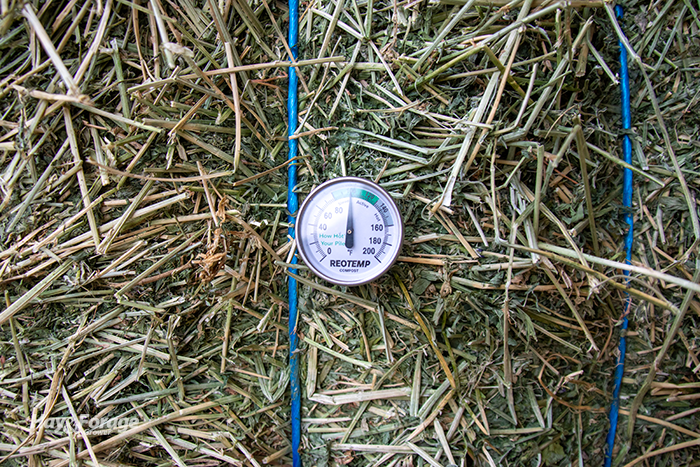
Hay fires become cause for concern when forage is baled too wet. Whether hay gets rained on or just doesn’t have enough time to dry down to proper baling moisture, wet bales can make a good harvest go up in flames — literally.
In the midst of a wet hay season, Jason Hartschuh with Ohio State University Extension reports that even when it hasn’t been raining in the Buckeye State, high humidity has sabotaged hay drying. This isn’t helped when cut forage is lying on wet soil, keeping moisture levels high and ramping up the risk of spoilage once it is baled.
In addition to causing spoilage, moisture is a catalyst for spontaneous combustion. Bacteria that thrive in wet bales generate heat, and these rising temperatures can create a shift in bacterial activity that makes the threat of hay fires a reality.
“At over 20% moisture, mesophilic bacteria release heat, causing the temperature to rise to 130ºF to 140ºF, with the temperature staying high for up to 40 days,” Hartschuh explains in a recent Ohio BEEF Cattle newsletter. “As temperatures rise, thermophilic bacteria can proliferate in your hay, raising the temperature into the fire danger zone, exceeding 175ºF.”
Therefore, it’s critical to monitor hay temperature daily when it’s stored above 18% moisture. Hartschuh notes that all hay above 15% moisture will undergo a heating and sweating process, in which hay temperatures typically peak at about 125ºF to 130ºF within three to seven days after baling. “After the peak temperature is reached, hay generally returns to normal temperature over the next 15 to 60 days,” he states.
If temperatures do not return to normal and/or reach to 150ºF, begin monitoring bale temperature twice a day. Options to do so include using cables, temperature probes, or by putting a thermometer into a perforated pipe or electrical tube and inserting this makeshift probe into bales. Hartschuh says farmers can also insert a rod into the center of a bale and manually assess hay temperature by touch or with an infrared thermometer, although this method is the least accurate.
“When monitoring hay temperature, be very cautious; hot hay can burn within the stack and cause cavities underneath that you can fall into,” Hartschuh asserts. He recommends walking on planks to spread your weight out on bales, wearing a harness attached to the ceiling in case you fall into a burned-out cavity, and always working in pairs. Continue monitoring hay temperatures for at least six weeks, or until temperatures stabilize within the safe zone under 160ºF.
Hartschuh provides these benchmarks to determine necessary action when monitoring hay temperature. Overall, do not move bales without assistance from the fire service if temperatures exceed 175ºF.
• 125ºF — No action is needed.
• 150ºF — Hay is approaching the danger zone. Check temperatures twice a day. Disassemble stacked bales and move them outside to allow air circulation to cool the hay.
• 160ºF — Hay has reached the danger zone. Check temperatures every few hours — but be cautious. Carefully disassemble stacked bales to create airflow but be aware of hot spots. Have a tank of water available while unstacking.
• 175ºF to 190ºF — Hot spots and fire pockets are likely. Alert the local fire service of a possible hay fire incident. Close barns to minimize air movement around the hay. Remove hot hay with assistance from the fire service. Bales may burst into flames, so keep tractors wet to avoid catching fire.
•200ºF or higher — Fire is present within the haystack near the temperature probe. Remove hot hay with assistance from the fire service. If possible, inject water into the hot spot to cool the hay before moving it. At this point, a fire will more than likely occur, so keep tractors wet and keep fire hose lines charged along the route where moved bales will be stacked.
Hartschuh adds that applying acid preservatives to wet hay can help stabilize temperatures, and propionic acid-based products can effectively inhibit bacterial growth in hay that is up to 25% moisture. With that said, these bales can still heat to dangerous levels. “If hay was baled between 15% to 20% moisture and acid preservatives were used, there is still potential for hay fire, but it’s not as great as on nontreated hay,” Hartschuh states.
Be aware that acid preservatives that contain ethoxyquin or butylated hydroxytoluene can produce hydrogen cyanide at 240ºF or higher. Hartschuh notes that products that primarily contain propionic acid do not carry this risk.

